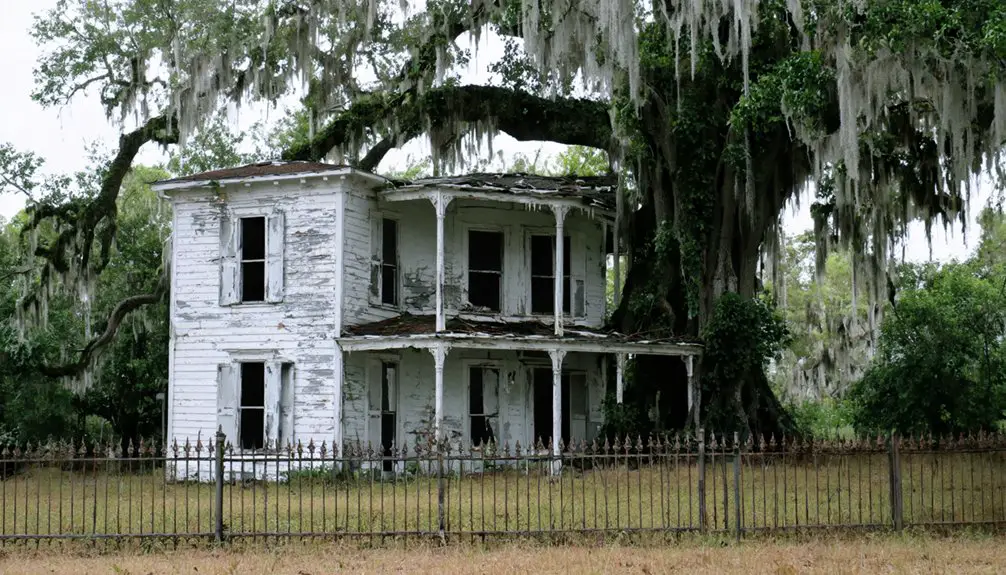You’ll find Gardner, Florida tucked away in DeSoto County at 27° 21′ 8.28″ N latitude and 81° 48′ 7.56″ W longitude. This ghost town‘s mysterious origins are linked to the Florida East Coast Railroad and agricultural development, with military significance dating back to the Second Seminole War. While official records remain scarce, surviving landmarks like the Oriole Cemetery and scattered infrastructure tell tales of its past. Gardner’s story reveals deeper truths about Florida’s forgotten frontier settlements.
Key Takeaways
- Gardner is a ghost town in DeSoto County, Florida, located at coordinates 27° 21′ 8.28″ N, 81° 48′ 7.56″ W.
- The town’s decline was linked to changes in transportation patterns and shifting industries in south-central Florida.
- Historical documentation of Gardner is sparse, with gaps in official records, land deeds, and census documents.
- Oriole Cemetery and scattered infrastructure remnants, including old buildings and railway foundations, are the main surviving landmarks.
- The town’s history connects to Fort Gardiner, which served as a military headquarters during the Second Seminole War.
Location and Historical Context
Located in DeSoto County at 27° 21′ 8.28″ N latitude and 81° 48′ 7.56″ W longitude, Gardner stands as a tribute to Florida’s forgotten settlements.
You’ll find this ghost town in south-central Florida’s rural heartland, near Arcadia, where its geographical significance stems from its position along former transportation routes.
The town’s story mirrors the economic decline common to this region, where shifting industries and changing transportation patterns transformed once-thriving communities into abandoned reminders of the past.
While you can still access Gardner via U.S. Route, it’s now surrounded by Florida’s natural landscape of pine flatwoods and scrubland.
Accessible yet remote, Gardner rests peacefully among Florida’s native pines and scrubland, a quiet reminder of times past.
Like many ghost towns in the area, Gardner’s fate was sealed by the decline of local industries, including agriculture and possibly phosphate mining, that once sustained its population.
This pattern of decline is similar to other U.S. towns like Mayflower, AR that have faced significant economic challenges.
The area can be precisely located using UTM Zone 17R coordinates, providing researchers and historians with exact positioning data.
Mysterious Origins and Settlement
When you examine Gardner’s early history, you’ll find significant gaps in the official records and documentation from its founding period.
The town’s establishment appears linked to agricultural development and the Florida East Coast Railroad, though precise dates and details of the first permanent settlements remain unclear. Like the eerie accounts of the Bell Witch legend, many local stories about Gardner’s origins were passed down through oral tradition.
These historical uncertainties align with patterns seen in other Florida ghost towns, where early documentation was often lost or never properly maintained during rapid rural development. Similar to the Pierce family mansion, detailed records were only preserved through oral histories and personal accounts passed down through generations.
Early Settlement Records Gap
Despite extensive historical records of Florida’s 19th-century development, Gardner’s early settlement origins remain shrouded in mystery due to significant gaps in documentation.
You’ll find this settlement ambiguity reflected in the scattered records of early pioneer families like the Gardners, who migrated from Ohio during the westward expansion.
These archival challenges stem from several key factors:
- The region’s complex history of military fortifications and temporary settlements, particularly around Fort Gardiner in 1837
- Environmental obstacles like swampland that impeded organized town development and record-keeping
- The gradual, informal nature of family settlements rather than planned townships
The lack of indigenous and colonial-era documentation further complicates efforts to trace Gardner’s precise founding, making it one of Florida’s more enigmatic ghost towns.
Similar challenges faced early French settlers who established Fort Caroline in 1564, only to be driven out by Spanish forces shortly after.
The difficulties in establishing permanent settlements were exemplified by the military’s struggle to build a road through swampland near Fort Gardiner, which ultimately led to its abandonment.
Missing Historical Documentation
As historians attempt to piece together Gardner’s origins, they face a substantial void in historical documentation that extends well beyond typical archival gaps.
You’ll find no early land deeds, census records, or official settlement documents that definitively establish Gardner’s founding or development. The town’s very name remains a mystery, though it’s possibly connected to Captain George Washington Gardiner.
The archival challenges are particularly striking when you examine historical maps, which either omit Gardner entirely or place it inconsistently. Like many Florida settlements that experienced rapid rise and fall, Gardner’s history became lost to time.
You won’t discover any birth certificates, church records, or business registries tied to the settlement. Even archaeological evidence is nonexistent – there are no building foundations, cemeteries, or artifacts to confirm permanent habitation, leaving Gardner’s true story frustratingly elusive. Similar to the early turpentine camp of Etna, which vanished by 1915, Gardner’s physical traces have been completely erased from the landscape.
Military Connections and Regional Impact
You’ll find Fort Gardiner’s most significant contribution in its role as the First Brigade’s headquarters south of the Withlacoochee River during the Second Seminole War.
Colonel Zachary Taylor established the fort in December 1837, using it to coordinate over 1,000 troops and launch campaigns deep into Seminole territory. After the Battle of Okeechobee, the fort served as a crucial hospital facility for wounded soldiers. Much like Camp Gordon Johnston in Carrabelle, the fort was strategically positioned for military operations along Florida’s waterways.
The fort’s 18-foot log stockade, corner blockhouses, and strategic position on the Kissimmee River made it an essential link in Florida’s military defense network, despite its eventual abandonment due to surrounding swampland challenges.
Fort Gardiner’s Strategic Role
While the Second Seminole War raged across Florida in 1837, Fort Gardiner emerged as an important military stronghold under Colonel Zachary Taylor’s command.
Built between Lakes Hatchineha and Kissimmee, the fort’s strategic advantages included control over crucial waterways and proximity to Seminole territories. You’ll find this installation served as the headquarters for the First Brigade’s military tactics south of the Withlacoochee River.
The fort’s critical functions included:
- Coordinating troop movements and serving as a supply depot
- Supporting nearby fortifications like Fort Basinger to extend military reach
- Launching major offensives, including the march to the Battle of Lake Okeechobee
As a command center, Fort Gardiner helped integrate diverse forces and maintain pressure on Seminole resistance, though challenging terrain eventually led to its abandonment.
Seminole War Defense Network
Fort Gardiner’s role represented just one piece of an expansive military defense network that shaped Florida’s territorial control during the Second Seminole War.
You’ll find this network included strategically placed forts and trading posts along both Gulf and Atlantic coasts, implementing military strategies that aimed to confine Seminoles south of Fort King.
The Army’s defensive tactics evolved to include specialized training for swamp warfare at Fort Bankhead, while the Navy expanded operations into the rivers and Everglades.
Under leaders like Brig. Gen. Walker Keith Armistead, forces coordinated systematic campaigns that included burning Seminole food sources and deploying small military detachments for year-round operations.
North of Fort King, militia and volunteers maintained defensive lines while regular troops focused on southern operations.
Reasons for Abandonment
Despite its initial establishment as a military outpost in 1837, Gardner’s abandonment stemmed from multiple interconnected challenges that proved insurmountable for long-term settlement.
You’ll find that environmental challenges posed significant barriers, with the surrounding Kissimmee River swampland making transportation and infrastructure development nearly impossible. The economic decline was inevitable as no sustainable industries could overcome the harsh natural conditions.
- Geographic isolation prevented the development of essential trade routes and commercial connections
- Constant flooding and poor drainage made agriculture and permanent construction unfeasible
- The transient nature of military personnel and early settlers failed to establish lasting community roots
Without adequate roads, stable civic facilities, or economic opportunities, families and businesses gradually moved to more accessible locations, leaving Gardner to fade into history.
Surviving Landmarks and Structures

Although time has eroded much of Gardner’s original infrastructure, you’ll find several notable landmarks and structures that have endured through decades of abandonment.
The Oriole Cemetery stands as one of the most significant surviving structures, with its weathered tombstones offering glimpses into the lives of early settlers.
You’ll discover dilapidated homes near main roads, some still featuring distinctive elements like chimneys and old porches with rocking chairs.
Former commercial buildings, including abandoned fueling stations and river stores, dot the landscape alongside the remnants of public structures.
Throughout the area, you’ll encounter wooden shacks, barns, and agricultural buildings slowly succumbing to nature’s reclamation.
While landmark preservation remains minimal, scattered infrastructure pieces like bridge foundations and railway remnants still mark the town’s former layout.
Legacy in Florida Ghost Town History
Like many abandoned settlements across Florida, Gardner’s legacy interweaves with pivotal moments in the state’s military and economic history.
You’ll find its cultural significance deeply rooted in the Second Seminole War, where Colonel Zachary Taylor established Fort Gardiner in 1837. The town’s namesake, Captain George Washington Gardiner, fell during the Dade Massacre of 1835, forever linking the settlement to Florida’s military past.
The town’s story reflects broader economic changes that shaped Florida’s development:
- Exemplifies how military outposts influenced early settlement patterns
- Demonstrates the volatile nature of frontier communities and their vulnerability to economic shifts
- Preserves the memory of early pioneers through oral histories and historical records
Today, Gardner stands as a symbol to the impermanence of frontier settlements and their lasting impact on Florida’s identity.
Frequently Asked Questions
Were There Any Indigenous Settlements in Gardner Before It Became a Town?
While there’s no direct record of Indigenous tribes in Gardner itself, you’ll find evidence of early settlements by Seminole and other native peoples throughout the surrounding central Florida region.
What Natural Resources or Industries Sustained the Earliest Gardner Settlers?
Pioneering people like you’d prosper from plentiful timber resources along the Kissimmee River, plus fishing, freshwater access, and agricultural practices near the riverbanks. Military infrastructure later supported additional settlement opportunities.
Did Any Notable Crimes or Legends Emerge From Gardner’s History?
You won’t find any documented historical crimes or ghostly encounters from Gardner’s past. The site primarily served as a military post during the Second Seminole War without developing notable legends.
How Did Transportation Routes Affect Gardner’s Development and Eventual Decline?
You’ll find Gardner’s destiny was tied to railroad impact – first thriving when the Atlantic Coast Line served it, then fading when route shifts isolated the town from essential transport networks.
What Evidence Exists of Gardner’s Cemetery or Burial Grounds?
You’ll find limited historical records of Gardner’s cemetery, though typical patterns suggest it existed. Unlike nearby ghost towns’ documented grave markers, Gardner’s burial grounds remain largely unverified through physical evidence.
References
- https://usghostadventures.com/haunted-places/pierce-mansion/
- https://www.legendsofamerica.com/fort-gardiner-florida/
- https://stluciehistoricalsociety.net/the-gardner-house/
- https://frontier-florida.blogspot.com/2017/05/eldora-florida-ghost-town.html
- https://www.youtube.com/watch?v=kXGAKmjGMXg
- https://www.latlong.net/place/gardnerville-nv-usa-3518.html
- https://kellycodetectors.com/content/pdf/site_locator_books/FL.pdf
- https://latitude.to/articles-by-country/us/united-states/314720/gardner-florida
- https://www.geodata.us/usa_populated_places/usapop.php?featureid=295311&f=usa_pop_30
- https://en.wikipedia.org/wiki/List_of_ghost_towns_in_Florida



